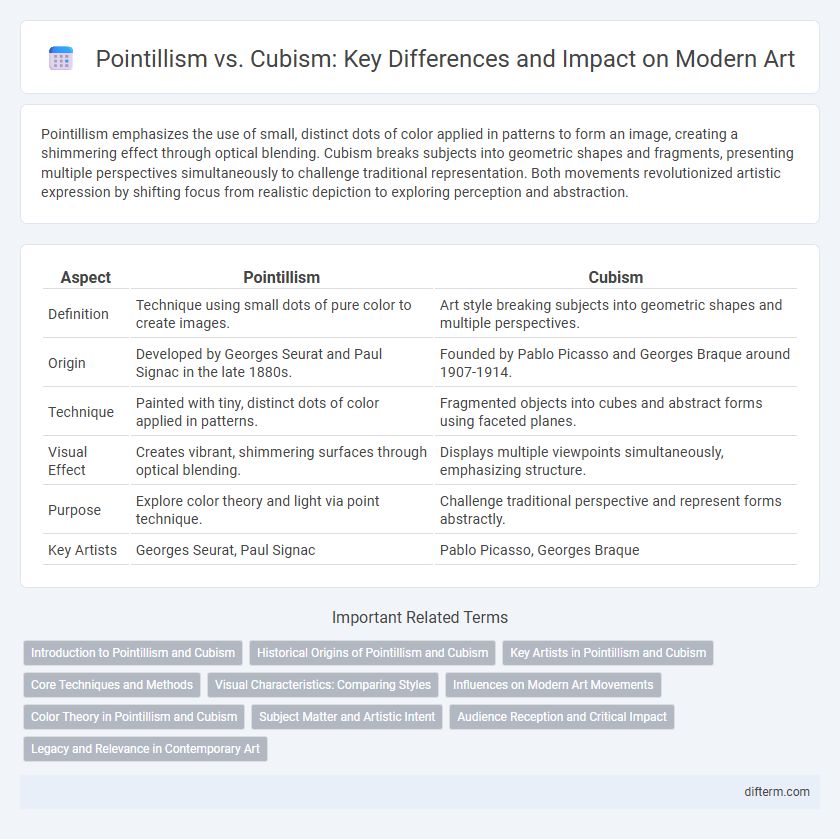Pointillism emphasizes the use of small, distinct dots of color applied in patterns to form an image, creating a shimmering effect through optical blending. Cubism breaks subjects into geometric shapes and fragments, presenting multiple perspectives simultaneously to challenge traditional representation. Both movements revolutionized artistic expression by shifting focus from realistic depiction to exploring perception and abstraction.
Table of Comparison
| Aspect | Pointillism | Cubism |
|---|---|---|
| Definition | Technique using small dots of pure color to create images. | Art style breaking subjects into geometric shapes and multiple perspectives. |
| Origin | Developed by Georges Seurat and Paul Signac in the late 1880s. | Founded by Pablo Picasso and Georges Braque around 1907-1914. |
| Technique | Painted with tiny, distinct dots of color applied in patterns. | Fragmented objects into cubes and abstract forms using faceted planes. |
| Visual Effect | Creates vibrant, shimmering surfaces through optical blending. | Displays multiple viewpoints simultaneously, emphasizing structure. |
| Purpose | Explore color theory and light via point technique. | Challenge traditional perspective and represent forms abstractly. |
| Key Artists | Georges Seurat, Paul Signac | Pablo Picasso, Georges Braque |
Introduction to Pointillism and Cubism
Pointillism, developed by Georges Seurat in the late 19th century, is characterized by the meticulous application of small dots of pure color to create images through optical blending. Cubism, pioneered by Pablo Picasso and Georges Braque in the early 20th century, breaks subjects into geometric shapes and presents multiple perspectives simultaneously. Both movements revolutionized traditional representation by emphasizing innovative techniques to challenge visual perception.
Historical Origins of Pointillism and Cubism
Pointillism, developed in the late 1880s by Georges Seurat and Paul Signac, emerged as a branch of Post-Impressionism emphasizing the application of small, distinct dots of color to form an image, rooted in contemporary color theory and optics. Cubism originated in the early 20th century, pioneered by Pablo Picasso and Georges Braque, breaking away from traditional perspective by representing subjects from multiple viewpoints and fragmenting forms into geometric shapes. Both movements revolutionized artistic representation by challenging conventional techniques and influenced the trajectory of modern art.
Key Artists in Pointillism and Cubism
Georges Seurat and Paul Signac are pivotal figures in Pointillism, pioneering the technique of applying small dots of pure color to create vibrant optical effects. In Cubism, Pablo Picasso and Georges Braque revolutionized visual representation by breaking objects into geometric shapes and multiple perspectives. Both movements redefined artistic expression through distinct approaches to form and color, influencing modern art profoundly.
Core Techniques and Methods
Pointillism employs meticulous application of tiny, distinct dots of pure color, relying on optical blending to form images and achieve vibrant luminosity. Cubism deconstructs subjects into geometric shapes and multiple perspectives, using fragmented planes and overlapping facets to represent three-dimensional forms on a two-dimensional surface. The core technique in Pointillism emphasizes color theory and precision in dot placement, whereas Cubism focuses on abstraction and spatial complexity through simultaneous viewpoints.
Visual Characteristics: Comparing Styles
Pointillism is characterized by the use of small, distinct dots of pure color applied in patterns to form an image, emphasizing light and color interaction to create a shimmering effect. Cubism breaks subjects into geometric shapes and fragmented viewpoints, presenting multiple perspectives within a single plane to challenge traditional representation. Pointillism relies on optical blending of color, while Cubism focuses on abstracting form and structure, highlighting the contrast in visual approaches between the two styles.
Influences on Modern Art Movements
Pointillism's precise application of color dots profoundly influenced modern art movements such as Neo-Impressionism and Op Art by emphasizing optical effects and color theory. Cubism revolutionized spatial representation, inspiring Abstract Expressionism and Futurism through its fragmented forms and multiple perspectives. Both movements fundamentally reshaped visual perception and artistic abstraction in 20th-century art.
Color Theory in Pointillism and Cubism
Pointillism relies on the optical mixing of pure color dots placed closely to create vibrant, luminous effects based on additive color theory, enhancing the perception of hues through viewer interaction. In contrast, Cubism employs a fragmented palette emphasizing muted tones and simultaneous perspectives, focusing less on color harmony and more on form and structure to convey multiple dimensions. The color theory in Pointillism aims to evoke luminosity and vibrancy, while Cubism uses color to deconstruct reality and challenge traditional visual representation.
Subject Matter and Artistic Intent
Pointillism emphasizes natural scenes and everyday life, using tiny dots of pure color to capture light and atmosphere, aiming to create a luminous and harmonious visual experience. Cubism breaks down subjects into geometric shapes and multiple perspectives, often abstracting objects to explore form and structure beyond traditional representation. While Pointillism seeks to replicate optical effects and vibrant realism, Cubism challenges perception by reconstructing reality through fragmented, analytical viewpoints.
Audience Reception and Critical Impact
Pointillism's meticulous dot technique captivated audiences with its luminous vibrancy, appealing to viewers fascinated by optical effects and light interplay, while critics praised its scientific approach to color theory. In contrast, Cubism's fragmented and abstract forms challenged traditional perspectives, initially provoking mixed reactions but eventually gaining acclaim for revolutionizing visual representation and influencing modern art critics and scholars. Both movements significantly impacted the trajectory of art history, with Pointillism emphasizing color perception and Cubism redefining form and spatial perception.
Legacy and Relevance in Contemporary Art
Pointillism's meticulous dot technique revolutionized color theory and influenced digital pixel art, while Cubism's fragmented forms challenged traditional perspective, shaping modern abstract expressionism. Contemporary artists draw on Pointillism's emphasis on optical blending and Cubism's multi-angle representation to explore new dimensions of visual perception and narrative complexity. Both movements remain pivotal, informing current practices in mixed media, installation art, and virtual reality experiences.
Pointillism vs Cubism Infographic

 difterm.com
difterm.com